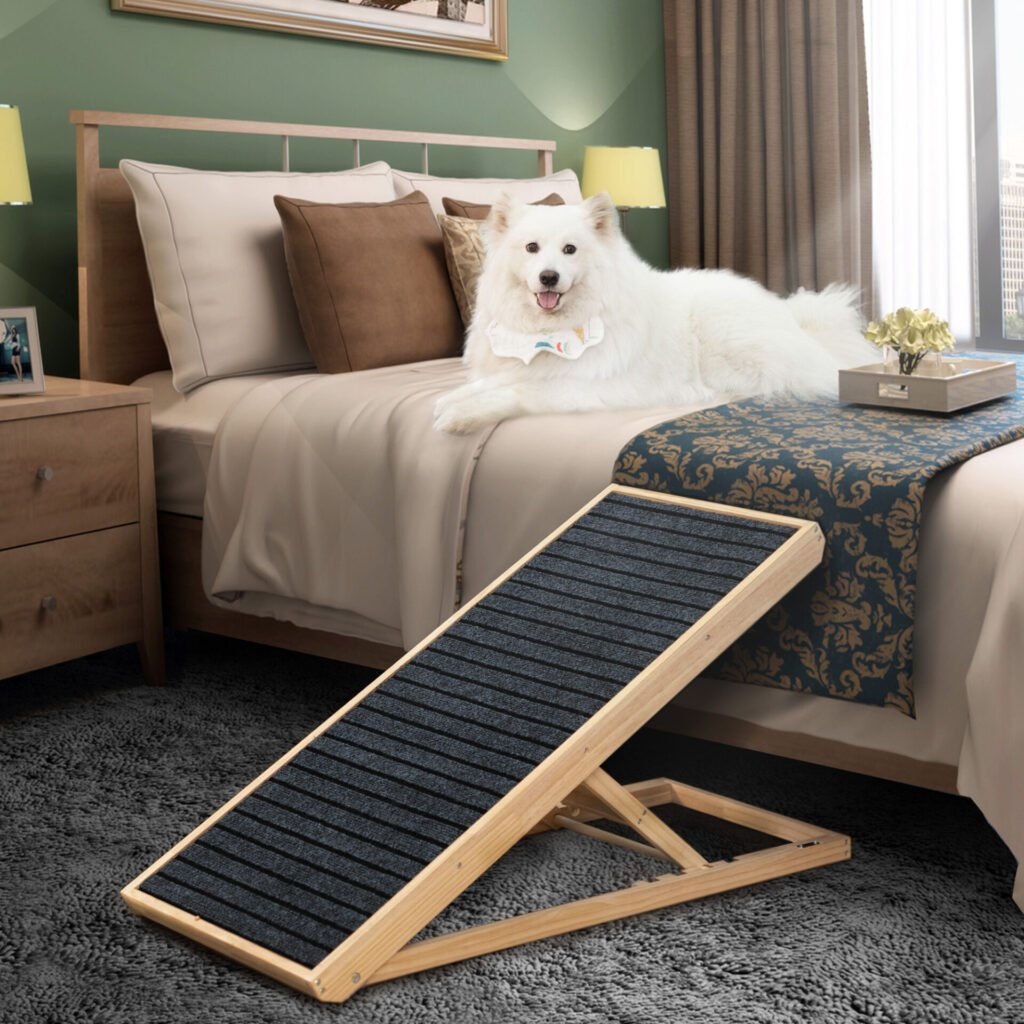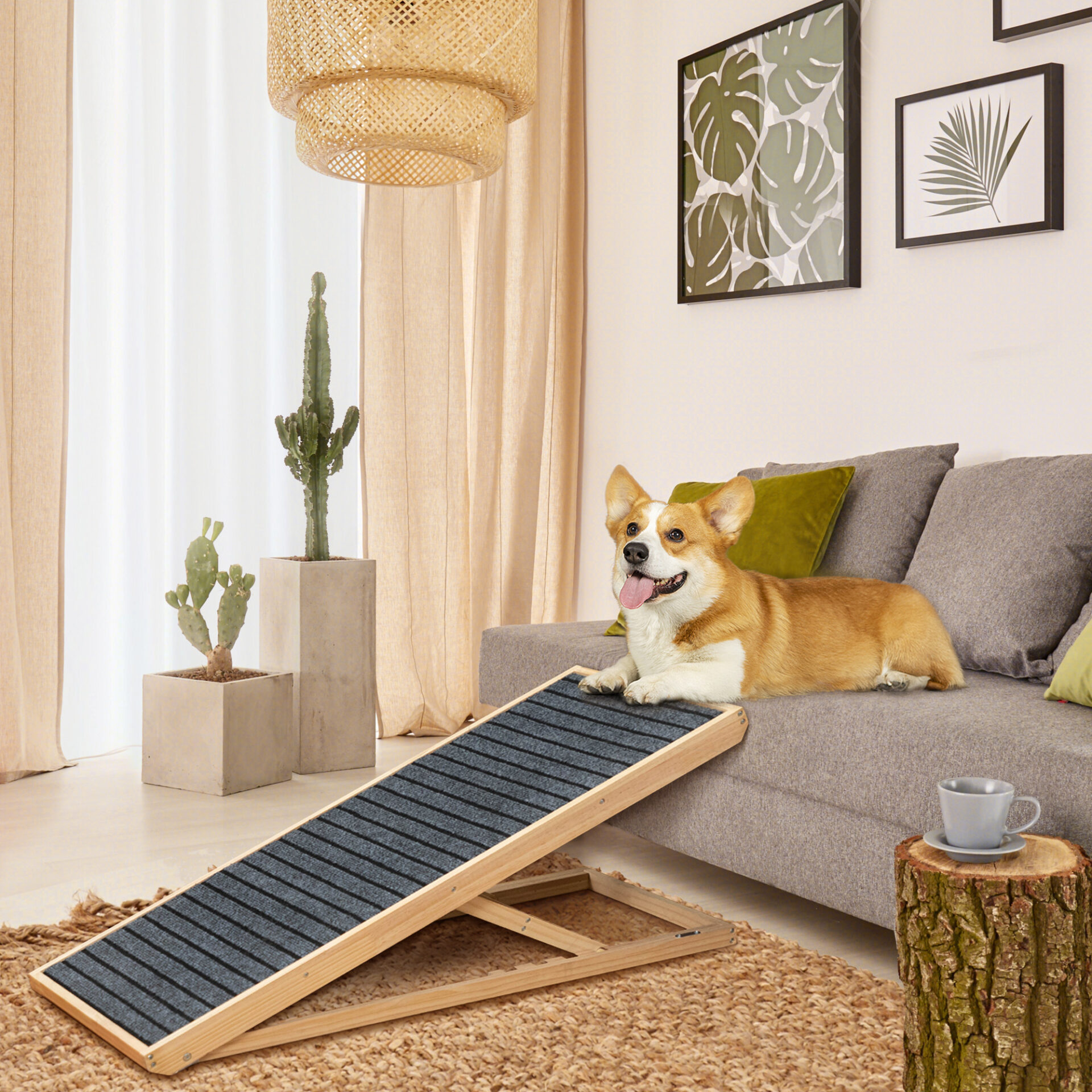If you own a dog, you’ve probably had this thought – and not having to help my dog get on the bed or into the car every time. If you are still thinking about adding a four-legged friend to your family, you will do so in the future. There is, however, a very simple solution to this problem. All you need is a dog ramp to make your dog’s life easier. As well as yours.
What is a dog ramp?
It is a surface that allows your pet to move from one level to the next. For example, to easily transition from the floor to a bed, sofa, etc. They are available in a variety of sizes, including those that can be adjusted in height as needed. They are typically made of plastic or wood and can be customized to match the décor of your home.
What is it for?
Dog ramps are extremely useful for people who have small puppies or senior dogs. Also suitable for those whose dogs are ill, have joint problems, or are disabled. The dog ramp allows the dog to be independent as well as risk-free because it eliminates the need for the dog to attempt to jump on a higher surface. Because dogs underestimate their chances of jumping, they are frequently injured. And such a situation will be extremely inconvenient for both you and your dog, after which you will almost certainly need to purchase a dog ramp.
The main benefits of having a dog ramp.
It will make life easier for the dog and protect it from potential injuries. Meanwhile, buying a dog ramp will save you a lot of time because you won’t have to help your dog every time it wants to get on the bed or couch. It is also not a short-term investment. Your dog will use this tool on a daily basis for many years.
The main drawback may be beneficial as well.
The most significant disadvantage of having dog ramps is the loss of room space. However, if space is an issue for you, you can go with a functional ramp. For instance, the one that is simple to fold. A ramp of this size will take up very little space and will fit perfectly in a closet or under the bed. Another option is to get a dog ramp that also functions as a shelf or storage box. Space will be used functionally in this manner.
So, are dog ramps worth it?
The answer is unequivocally yes. Some people are hesitant to buy a dog ramp because they are concerned about the cost or how it will look in their apartment. However, delaying getting off a dog ramp often means paying a few times more to the vet after a pet fails to jump on the bed. Meanwhile, in terms of design, you can definitely find something that will complement your interior while also being functional.
Ramp Training for Senior Pets
Ramp up your senior pet’s quality of life by introducing a pet ramp for the car, couch, or bed. Ramps provide easy access to elevated places and reduce your senior pet’s risk of fall-related injuries that commonly occur when pets jump up to or down from elevation.
While ramps can help your pet maintain their normal routine, selecting the correct ramp and a proper introduction to your pet is important. Positive training builds your pet’s confidence and understanding, increasing the likelihood that they will use the ramp consistently.

How to select the best ramp for your senior pet
Choosing the right pet ramp can make training a lot easier.
* A textured surface — Look for textured rubber, artificial turf, or a carpeted surface in an ideal ramp. Gritty sandpaper-like surfaces are insufficient for some dogs.
* Stability — The ramp top should have non-slip rubber feet or a similar feature to keep the ramp from sliding while in use. * Portability — Car ramps should be simple to store, install, and transport. Look for a portable model that can be telescoped or folded.
* Size — To ensure proper fit, measure the height of your furniture or car. Ramps that are too short will create a dangerously steep angle for your pet.
How to train your pet to use a ramp
When you’ve finished building your pet’s ramp, it’s time to teach an old dog or cat new tricks: * Introduce the ramp gradually over several days or more.
* A few times per day, practice in brief but highly reinforcing one- to three-minute sessions.
* Practice before meals to keep your pet motivated and focused.
Train your pet at his or her own pace. If they are scared or nervous, take a break and restart where your pet was successful. You may skip unnecessary steps for the overachiever pet.
* Prepare for success by laying out the ramp before bringing your pet into the room—unfolding or moving the ramp can be frightening to some pets. Place the ramp flat on the ground, textured side up. Make plenty of small tasty treat rewards.
Bring your pet to the ramp area to reward any and all interactions. Keep an eye on your pet and reward them if they show any interest in the ramp (e.g, sniffing, touching with any paw, or walking nearby).
– Place a treat on the ramp if your pet appears to be confident. Hand-deliver treats to less trusting pets.
* Take your pet for a walk — Some pets learn through imitation. Try walking across the width of the ramp, encouraging your pet to follow. Reward your pet regardless of whether they walk or jump across. Repeat as needed.
* Make a trail of treats or toys — Place a trail of treats across the width of the ramp to encourage more focused movement (i.e., short end). Change the length and angle of your trail until your pet is walking smoothly across the length of the ramp.
* Commemorate standing still — If your pet is scrambling or hurrying across the ramp, they are still uneasy. Place the ramp against a wall and walk alongside your pet, feeding a treat every step at first, then every two, three, or four steps. Next, take a brief pause before administering the treat. This instills value in standing still and teaches your pet that only good things happen on the ramp.
* Raise the ramp — Once your pet has mastered the skills listed above, introduce some height. For your senior pet’s safety, use a harness and leash during the advanced stages of training.
– Substitute a phone book or another low, solid object under one side of the ramp. Walk your dog “up” and frequently reward them. Lift them off at the top or keep an eye on them as they step down. Try going “down” as well as “up” several times.
– Increase the height gradually by using couch cushions, a low ottoman, a stair, or other secure surfaces.
– Be patient and keep an eye out for your dog as they ascend and descend.
* Install the ramp — Place your pet’s ramp in its proper location. At this point, your pet should require fewer treats. Always leave enough space at the ramp’s base for your pet to make a straight approach and exit.
* Keep an eye on your pet — Because pets can fall back on old habits, your pet may need to be reminded to use the ramp on occasion. Praise lavishly and reward at random.
If your senior pet’s mobility, health, or quality of life has declined suddenly or significantly, please visit our dog ramp for assistance.

